This recipe cracks me up. Each little brioche roll has 1¼ tablespoons of butter in it, so it doesn’t matter how much whole grain you use – these are not good for you.
They are, however, good. Of course they don’t have much in common with their white flour cousins, which, if we were talking about people, would be one of those unceasingly friendly people who always have something nice to say. The whole wheat version is more akin to a sarcastic friend who always manages to make you laugh, but sometimes at your own expense. Both are good! Just different.
The whole wheat brioche is made along the same lines as the rest of Peter Reinhart’s Whole Grain Breads. What’s fun about this recipe is that the liquid used in one of the pre-doughs is melted butter, and in the other, it’s eggs. The one with the butter had a texture very different from the normal water-hydrated doughs – and not a particularly appetizing one, truth be told, as the best word to describe it would be ‘greasy’. Fortunately, after sitting in the fridge for several hours, the butter hardens and the mixture is more palatable – plus, of course, the liquid has had an opportunity to break down those bran fibers, which is the heart of Reinhart’s whole wheat bread method.
I tried a trick with this bread that was marginally successful. After the final dough is mixed and kneaded, it’s shaped immediately and then needs to rise again – for 3 to 4 hours. We tend to eat breakfast kind of late on weekends, but not that late!
So I reduced the yeast quite a bit, with the goal of extending the rising time to about 8 hours, or overnight. I wanted to wake up, heat the oven and throw the perfectly risen brioche rolls in to bake.
It turns out, though, that I decreased the yeast too much, and the poor little guys didn’t have enough strength to lift up that heavy dough. I still think the method is sound; I just need to use more yeast than I did. (The under-risen after 8 hours brioche were salvageable; I just had to give them an hour or so in a really warm environment before I could bake them.)
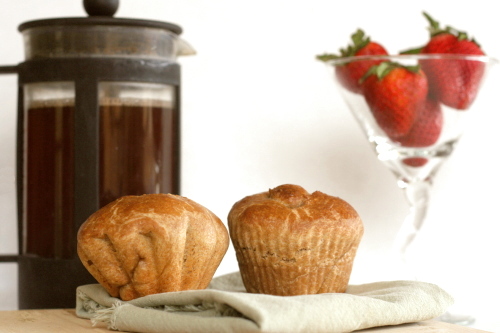
Usually my theory is that if food is supposed to be indulgent, then make it indulgent! Why worry about whole grains if you’re mainlining butter? But sometimes it’s just fun to make something weird, and whole wheat brioche is, indeed, weird.
One year ago: Pecan Sour Cream Biscuits
Two years ago: Chocolate Cream Pie
Printer Friendly Recipe
Whole Wheat Brioche (rewritten from Peter Reinhart’s Whole Grain Breads)
I reduced the yeast in the final dough to ½ teaspoon, hoping I could stretch the rising time to 8-10 hours, or overnight. This was too little, but I still think the method is worth trying, but with 1 teaspoon yeast.
I froze the brioche rolls after shaping, before rising. I let them defrost in the fridge for a few hours before moving them to room temperature to rise.
The melted butter kept leaking out of its pre-dough. Once the dough had chilled somewhat, I stirred it back in, so that the pre-dough would be homogeneous.
For the final cup of flour, after both pre-doughs are combined, I used white flour. I know that’s cheating, but I’ve had better results with Reinhart’s whole wheat bagels when white flour is used at the end, and I thought it was probably similar here. The rolls are still 80% whole wheat.
Pre-dough 1:
1¾ cups (8 ounces) whole wheat flour
½ teaspoon salt
½ cup whole milk, scalded and cooled
16 tablespoons (2 sticks) unsalted butter, melted
Mix all of the ingredients until thoroughly combined. Cover and refrigerate at least 8 hours and up to 3 days.
Pre-dough 2:
1¾ cups (8 ounces) whole wheat flour
¼ teaspoon instant yeast
4 large eggs, slightly beaten
Mix all of the ingredients until thoroughly combined. Using a rubber spatula or wet hands, knead the dough in the bowl for a couple minutes; it will be very tacky. Let the dough rest for 5 minutes, then knead again for 1 minute. Cover and refrigerate for at least 8 hours and up to 3 days.
Final dough:
Both pre-doughs
1 cup (4.5 ounces) whole wheat flour (see note)
¾ teaspoon salt
2¼ teaspoons instant yeast (see note)
3 tablespoons sugar
Egg wash:
1 egg beaten with 1 tablespoon water and a pinch of salt
1. Chop the chilled pre-doughs into to 12 pieces each. Combine the pre-doughs, flour, salt, yeast and sugar in the bowl of a standing mixer fitted with the dough hook (or a large bowl if mixing by hand). Mix on slow speed for 3 to 4 minutes, scraping the bowl as needed, (or knead with wet hands) until the pre-doughs are assimilated into each other. Add flour or water, as needed, to form a soft and slightly sticky dough. Knead (either with a mixer or by hand) for 3 to 4 minutes, until the dough is cold, firm, and slightly tacky. Let the dough rest for 5 minutes.
2. Divide the dough into 12 equal pieces and round each into a smooth ball. Spray 12 brioche molds or a 12-cup muffin pan with spray oil. To shape the brioche, roll each piece of dough into a cone; poke a hole through the larger end and slip the small end through the hole. (I also sometimes just formed a much smaller round from a small portion of the dough and stuck that on top of the larger round. I didn’t notice a difference in the baked versions of the two shaping methods.) Place the shaped rolls into the prepared pan and cover loosely with plastic wrap or a damp towel. Let rise at room temperature for 3 to 4 hours, until the dough has grown to about 1½ times its original size.
3. Adjust a rack to the middle position and heat the oven to 425 degrees. Brush the risen rolls with egg wash and place them in the oven, lowering the temperature to 400 degrees. Bake for 17 to 25 minutes, rotating the pan halfway through, until the brioche are dark golden brown, measure 195 degrees in the center, and sound hollow when tapped on the bottom (after one is removed from its pan).
4. Remove the rolls from their molds; cool on a cooling rack for at least 20 minutes before serving.
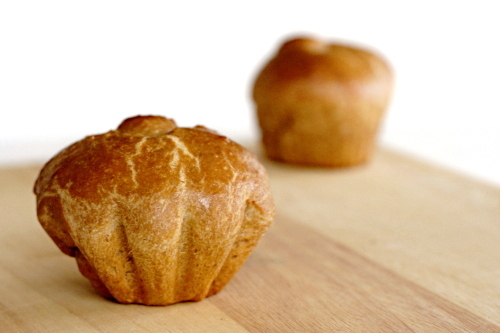
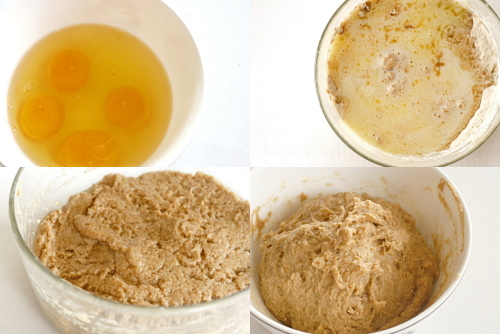
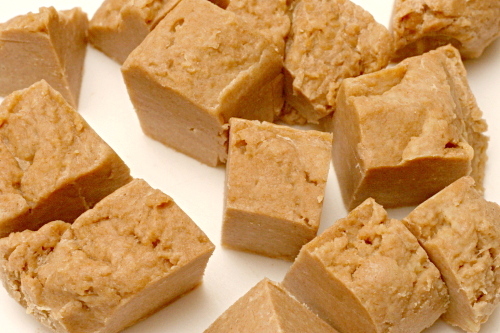
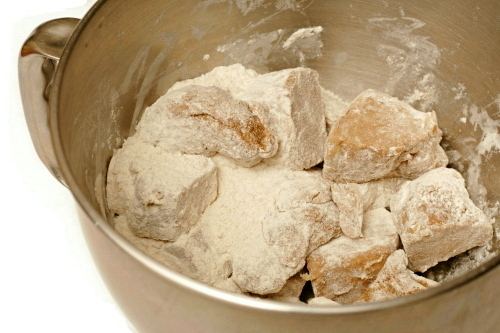
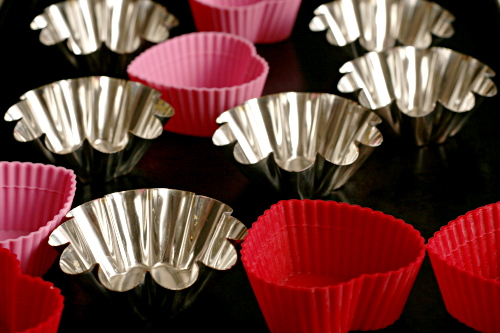
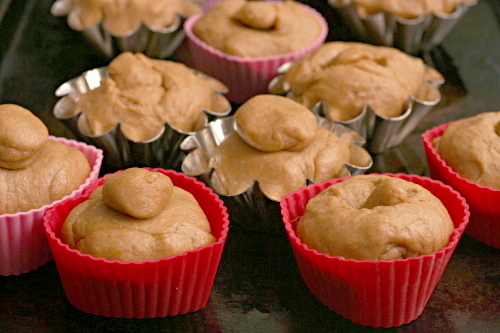
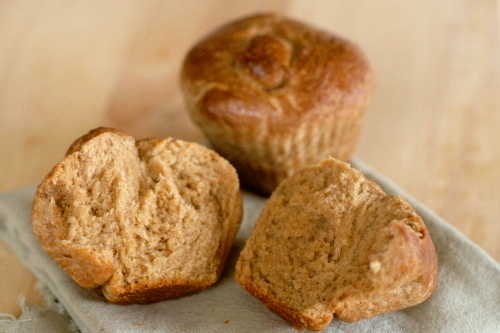
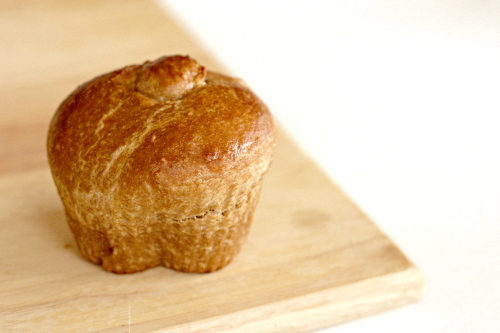






Hah, I’m sure there are people who actually prefer the flavor of whole wheat flour, fat or no fat. Unfortunately, I’m not one of those people… But I do like the approach you’ve taken here. I’m a little puzzled by the timing that Reinhart chose, but maybe he didn’t mean for these to be breakfast breads, or maybe he expects you to wake up at 3AM 🙂
I don’t think I care if they are good for you or not…they look amazing! Especially next to a french press 🙂 YUm!
So pretty!!! Love all the pictures. They look awesome. And I love that one with the strawberries in the glass. Great setup! 🙂
Those are so adorable! And if they’re not healthy, so be it! I’ll take one anyway! 🙂
Wow, these look great–and I LOVE your blog! So glad I found it 🙂
These are very cute. I love the buttery goodness of brioche. I can’t agree more with your comment about indulgence. I just dislike foods that are neither healthy or tasty, they are a waste of time.
I love weird. I never would have thought to put whole wheat and brioche together, but I’m glad it works! I love strawberry butter on white flour brioche rolls — what would you top these with? Maybe a flavorful jam?
They look amazing! Can’t wait to try this recipe.
GORGEOUS photos! Thank you for posting on TN about farro — the recipe with the carmelized onions looks fantastic! I will be trying it soon!
Love, love, love your blog…keep up the great work! I’m adding you to my blogroll 🙂
Ha! I am “one of those people”. Whole wheat flour is tastier than white any day of the week. And the best new nutrition research out is that butter is good for you–as long as it’s top quality butter (organic at leat, grass fed if you can get it).
Manggy and Heather – My feeling is that if you don’t love both white bread and whole wheat bread – as two different but equal things – then you’re not eating/making the right recipes! You can’t beat the sweetness and complexity evident in a perfect rustic white bread, but sometimes the extra flavor from whole grains is wonderful as well.
OH!!! YUM!! Those look fantastic. Love brioche, but have not made with wwf. Have to try these. And lots of butter. What could be wrong with that?
I frequently make my regular caramel roll recipe and let them chill overnight. I take them straight from the fridge to the oven in the morning and they come out perfect. It never occurred to me to adjust the yeast, so I guess ignorance is bliss! 🙂
Hi–I tried to make the same recipe but my mixture got completely solid after being in the refrigerator overnight bc of the butter–did yours? How did you adapt for that? i literally had to chip it out of the bowl and it seems like once it got soft enough to knead it went from there to butter leaking out of the dough in like 2 seconds.
Sandy – I haven’t made these in years, but I have a note above that says that I stirred the buttery pre-dough after it had been in the fridge just long enough for the butter to solidify, which helped that pre-dough homogenize. Maybe that kept the butter from leaking out of the dough while it was kneading. I hope the brioche came out well for you in the end.